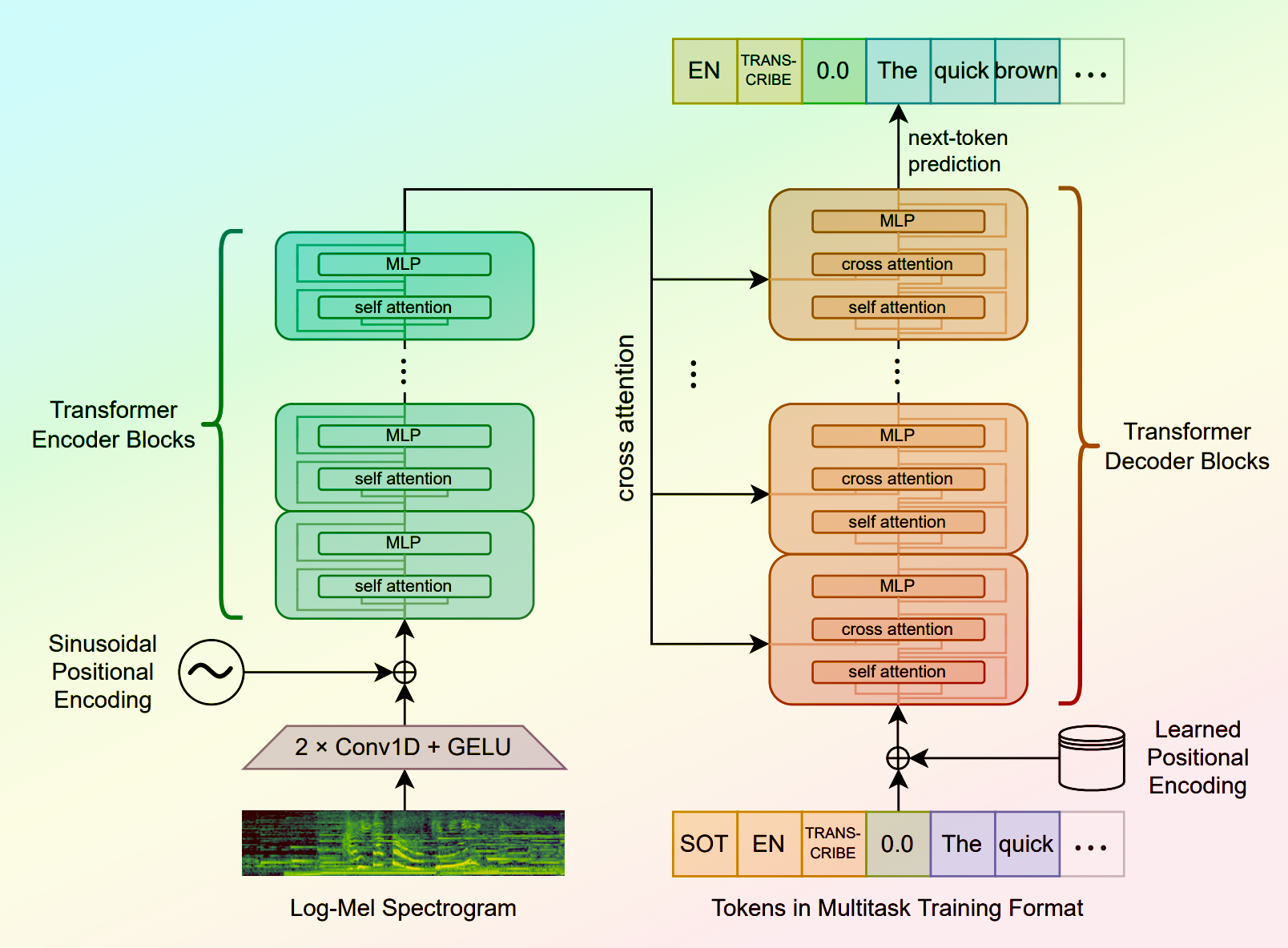whisper-subtitles
Maintainer: m1guelpf

51

| Property | Value |
|---|---|
| Model Link | View on Replicate |
| API Spec | View on Replicate |
| Github Link | View on Github |
| Paper Link | View on Arxiv |
Create account to get full access
Model overview
The whisper-subtitles model is a variation of OpenAI's Whisper, a general-purpose speech recognition model. Like the original Whisper model, this model is capable of transcribing speech in audio files, with support for multiple languages. The key difference is that whisper-subtitles is specifically designed to generate subtitles in either SRT or VTT format, making it a convenient tool for creating captions or subtitles for audio and video content.
Model inputs and outputs
The whisper-subtitles model takes two main inputs:
- audio_path: the path to the audio file to be transcribed
- model_name: the name of the Whisper model to use, with options like
tiny,base,small,medium, andlarge
The model outputs a JSON object containing the transcribed text, with timestamps for each subtitle segment. This output can be easily converted to SRT or VTT subtitle formats.
Inputs
- audio_path: The path to the audio file to be transcribed
- model_name: The name of the Whisper model to use, such as
tiny,base,small,medium, orlarge - format: The subtitle format to generate, either
srtorvtt
Outputs
- text: The transcribed text
- segments: A list of dictionaries, each containing the start and end times (in seconds) and the transcribed text for a subtitle segment
Capabilities
The whisper-subtitles model inherits the powerful speech recognition capabilities of the original Whisper model, including support for multilingual speech, language identification, and speech translation. By generating subtitles in standardized formats like SRT and VTT, this model makes it easier to incorporate high-quality transcriptions into video and audio content.
What can I use it for?
The whisper-subtitles model can be useful for a variety of applications that require generating subtitles or captions for audio and video content. This could include:
- Automatically adding subtitles to YouTube videos, podcasts, or other multimedia content
- Improving accessibility by providing captions for hearing-impaired viewers
- Enabling multilingual content by generating subtitles in different languages
- Streamlining the video production process by automating the subtitle generation task
Things to try
One interesting aspect of the whisper-subtitles model is its ability to handle a wide range of audio file formats and quality levels. Try experimenting with different types of audio, such as low-quality recordings, noisy environments, or accented speech, to see how the model performs. You can also compare the output of the various Whisper model sizes to find the best balance of accuracy and speed for your specific use case.
This summary was produced with help from an AI and may contain inaccuracies - check out the links to read the original source documents!
Related Models

whisper-subtitles

4
The whisper-subtitles model is a forked version of the m1guelpf/whisper-subtitles model, which uses OpenAI's Whisper speech recognition model to generate subtitles in .srt and .vtt formats from audio files. This model adds support for voice activity detection (VAD) to filter out parts of the audio without speech, the ability to select a language, and the use of language-specific Whisper models. It also allows you to download the generated subtitle files directly from the model output. Model inputs and outputs The whisper-subtitles model takes an audio file, a Whisper model name, a language, and an option to enable VAD filtering as inputs. It outputs the generated subtitle files in both .srt and .vtt formats. Inputs audio_path**: The path to the audio file to generate subtitles for. model_name**: The name of the Whisper model to use, with "small" being the default. language**: The language of the audio, with "en" (English) being the default. vad_filter**: A boolean value to enable or disable voice activity detection (VAD) filtering, which is set to true by default. Outputs srt_file**: The generated subtitle file in the SubRip Subtitle (.srt) format. vtt_file**: The generated subtitle file in the Web Video Text Tracks (.vtt) format. Capabilities The whisper-subtitles model can generate accurate subtitles for a wide range of audio files in different languages. It uses the powerful Whisper speech recognition model, which has been shown to perform well on various speech recognition tasks. The addition of VAD filtering and language-specific models further improves the quality and accuracy of the generated subtitles. What can I use it for? The whisper-subtitles model can be useful for a variety of applications, such as: Video captioning**: Add subtitles to your videos to make them more accessible and engaging for viewers. Podcast transcription**: Generate transcripts of your podcast episodes to make them searchable and shareable. Language learning**: Use the subtitles to improve your language skills by following along with audio content. Accessibility**: Provide subtitles for audio and video content to make it more accessible for people with hearing impairments. Things to try One interesting thing to try with the whisper-subtitles model is to experiment with the different Whisper model sizes and language-specific models. The "small" model is the default, but the larger models may provide better accuracy, especially for more complex or noisy audio. You can also try enabling and disabling the VAD filtering to see how it affects the quality of the generated subtitles.
Updated Invalid Date

whisper

15.8K
Whisper is a general-purpose speech recognition model developed by OpenAI. It is capable of converting speech in audio to text, with the ability to translate the text to English if desired. Whisper is based on a large Transformer model trained on a diverse dataset of multilingual and multitask speech recognition data. This allows the model to handle a wide range of accents, background noises, and languages. Similar models like whisper-large-v3, incredibly-fast-whisper, and whisper-diarization offer various optimizations and additional features built on top of the core Whisper model. Model inputs and outputs Whisper takes an audio file as input and outputs a text transcription. The model can also translate the transcription to English if desired. The input audio can be in various formats, and the model supports a range of parameters to fine-tune the transcription, such as temperature, patience, and language. Inputs Audio**: The audio file to be transcribed Model**: The specific version of the Whisper model to use, currently only large-v3 is supported Language**: The language spoken in the audio, or None to perform language detection Translate**: A boolean flag to translate the transcription to English Transcription**: The format for the transcription output, such as "plain text" Initial Prompt**: An optional initial text prompt to provide to the model Suppress Tokens**: A list of token IDs to suppress during sampling Logprob Threshold**: The minimum average log probability threshold for a successful transcription No Speech Threshold**: The threshold for considering a segment as silence Condition on Previous Text**: Whether to provide the previous output as a prompt for the next window Compression Ratio Threshold**: The maximum compression ratio threshold for a successful transcription Temperature Increment on Fallback**: The temperature increase when the decoding fails to meet the specified thresholds Outputs Transcription**: The text transcription of the input audio Language**: The detected language of the audio (if language input is None) Tokens**: The token IDs corresponding to the transcription Timestamp**: The start and end timestamps for each word in the transcription Confidence**: The confidence score for each word in the transcription Capabilities Whisper is a powerful speech recognition model that can handle a wide range of accents, background noises, and languages. The model is capable of accurately transcribing audio and optionally translating the transcription to English. This makes Whisper useful for a variety of applications, such as real-time captioning, meeting transcription, and audio-to-text conversion. What can I use it for? Whisper can be used in various applications that require speech-to-text conversion, such as: Captioning and Subtitling**: Automatically generate captions or subtitles for videos, improving accessibility for viewers. Meeting Transcription**: Transcribe audio recordings of meetings, interviews, or conferences for easy review and sharing. Podcast Transcription**: Convert audio podcasts to text, making the content more searchable and accessible. Language Translation**: Transcribe audio in one language and translate the text to another, enabling cross-language communication. Voice Interfaces**: Integrate Whisper into voice-controlled applications, such as virtual assistants or smart home devices. Things to try One interesting aspect of Whisper is its ability to handle a wide range of languages and accents. You can experiment with the model's performance on audio samples in different languages or with various background noises to see how it handles different real-world scenarios. Additionally, you can explore the impact of the different input parameters, such as temperature, patience, and language detection, on the transcription quality and accuracy.
Updated Invalid Date
🧠
whisper-downloadable-subtitles

2
The whisper-downloadable-subtitles model is an addition to the popular Whisper speech recognition model created by OpenAI. This model, maintained by cjwbw, adds the ability to generate downloadable subtitles for audio files. This is a useful feature for making audio content more accessible, as the subtitles can be used to provide captions or translations. The model is built on top of the whisper model, which is a large-scale speech recognition system that can transcribe speech in multiple languages. Model inputs and outputs The whisper-downloadable-subtitles model takes an audio file, a Whisper model, and a subtitle format as inputs. The audio file can be in various formats, and the Whisper model can be chosen from a range of available options. The subtitle format can be set to "None" or a specific format like "SRT" or "VTT". The model then outputs the transcribed text, which can be translated to English if desired. Inputs audio**: The audio file to be transcribed model**: The Whisper model to use for transcription subtitle**: The subtitle format to generate Outputs ModelOutput**: The transcribed text, which can be in the original language or translated to English Capabilities The whisper-downloadable-subtitles model can transcribe speech in multiple languages and generate subtitles in various formats. This makes it a useful tool for making audio content more accessible, particularly for people who are deaf or hard of hearing, or for those who need to consume content in a language they don't understand. The model's ability to translate the transcribed text to English is also a valuable feature. What can I use it for? The whisper-downloadable-subtitles model can be used in a variety of applications, such as: Video and audio content**: Adding subtitles to videos or podcasts to make them more accessible. Language learning**: Generating subtitles in multiple languages to help people learn new languages. Transcription services**: Offering transcription services for audio or video content. Accessibility tools**: Providing subtitles or captions for deaf or hard of hearing users. Things to try One interesting thing to try with the whisper-downloadable-subtitles model is experimenting with different Whisper models and subtitle formats to see how they affect the quality and accuracy of the transcription and subtitles. You could also try using the model on a variety of audio content, such as interviews, lectures, or podcasts, to see how it performs in different scenarios.
Updated Invalid Date

whisper-large-v3

3
The whisper-large-v3 model is a general-purpose speech recognition model developed by OpenAI. It is a large Transformer-based model trained on a diverse dataset of audio data, allowing it to perform multilingual speech recognition, speech translation, and language identification. The model is highly capable and can transcribe speech across a wide range of languages, although its performance varies based on the specific language. Similar models like incredibly-fast-whisper, whisper-diarization, and whisperx-a40-large offer various optimizations and additional features built on top of the base whisper-large-v3 model. Model inputs and outputs The whisper-large-v3 model takes in audio files and can perform speech recognition, transcription, and translation tasks. It supports a wide range of input audio formats, including common formats like FLAC, MP3, and WAV. The model can identify the source language of the audio and optionally translate the transcribed text into English. Inputs Filepath**: Path to the audio file to transcribe Language**: The source language of the audio, if known (e.g., "English", "French") Translate**: Whether to translate the transcribed text to English Outputs The transcribed text from the input audio file Capabilities The whisper-large-v3 model is a highly capable speech recognition model that can handle a diverse range of audio data. It demonstrates strong performance across many languages, with the ability to identify the source language and optionally translate the transcribed text to English. The model can also perform tasks like speaker diarization and generating word-level timestamps, as showcased by similar models like whisper-diarization and whisperx-a40-large. What can I use it for? The whisper-large-v3 model can be used for a variety of applications that involve transcribing speech, such as live captioning, audio-to-text conversion, and language learning. It can be particularly useful for transcribing multilingual audio, as it can identify the source language and provide accurate transcriptions. Additionally, the model's ability to translate the transcribed text to English opens up opportunities for cross-lingual communication and accessibility. Things to try One interesting aspect of the whisper-large-v3 model is its ability to handle a wide range of audio data, from high-quality studio recordings to low-quality field recordings. You can experiment with different types of audio input and observe how the model's performance varies. Additionally, you can try using the model's language identification capabilities to transcribe audio in unfamiliar languages and explore its translation functionality to bridge language barriers.
Updated Invalid Date